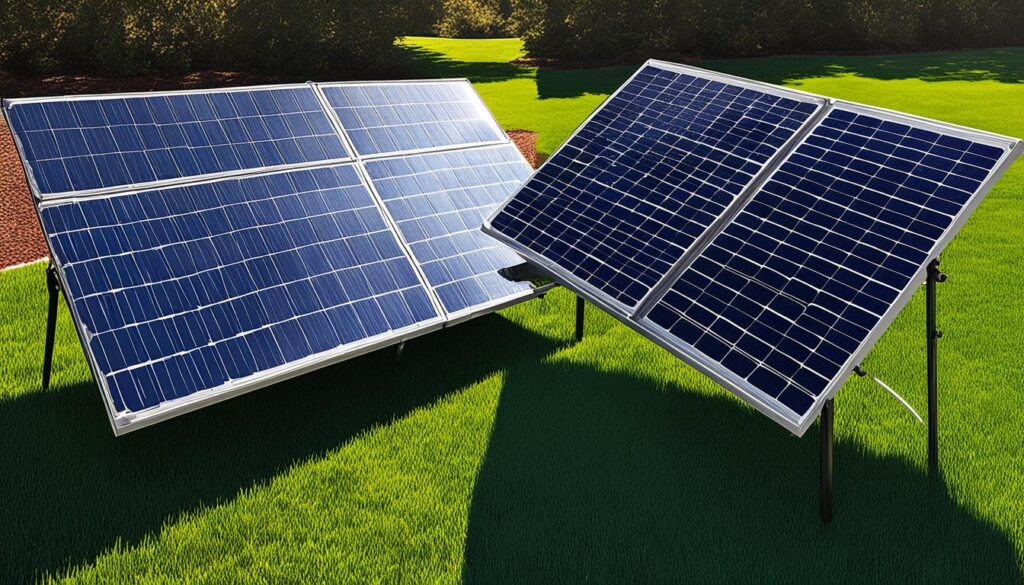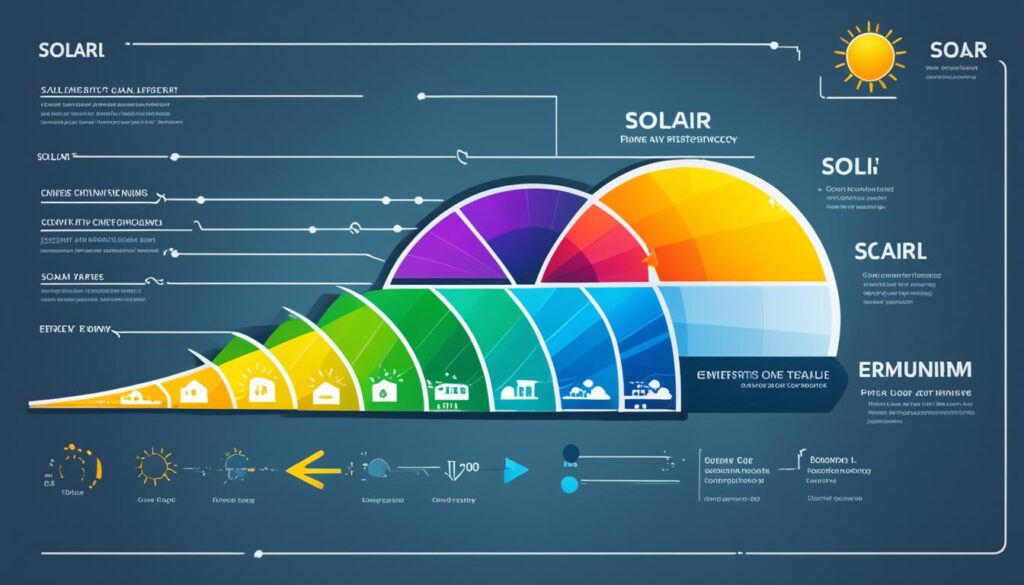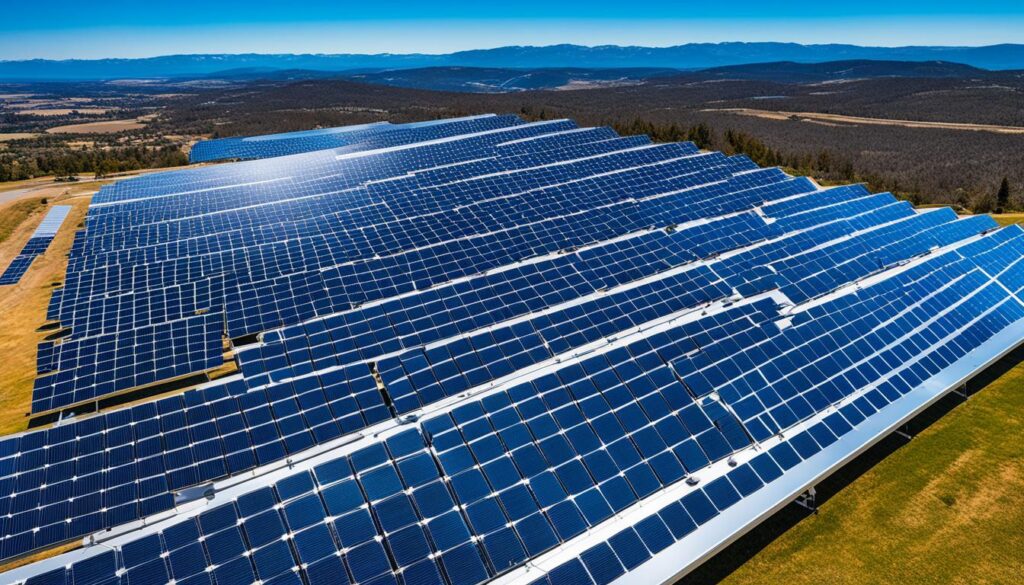Solar energy is now a top choice for many, offering renewable power. This guide looks at various solar panels, discussing their make, how they work, and more. Monocrystalline, polycrystalline, and thin-film panels differ in properties and prices.
The solar industry has boomed thanks to help from the government and a big need for greener power. By understanding solar panels better, you can pick the right one for your energy goals.
Key Takeaways
- Monocrystalline solar panels are the most efficient and long-lasting, but also the most expensive.
- Polycrystalline solar panels are more affordable but slightly less efficient than monocrystalline.
- Thin-film solar panels are the least expensive option, but also the least efficient, making them better suited for small-scale applications.
- Understanding the unique characteristics of each solar panel type can help consumers make an informed decision when investing in a solar energy system.
- The growth of the solar industry has been driven by factors such as federal support, commercial and industrial demand, and the need to reduce carbon footprints.
What are Solar Panels?
Solar panels collect energy from the sun and turn it into electricity. They have many solar cells each with layers of silicon, boron, and phosphorus. These layers help create electric charges, letting solar panels work.
Composition and Working Principle
Sun’s rays hit the solar panel. This contact makes electrons move. They create power in the form of a current. This is how photovoltaic panels, or solar panels, work.
The Photovoltaic Effect
The photovoltaic effect makes solar panels work. When sunlight touches a solar panel, it makes electrons move freely. This creates electricity. The solar panel turns this into the kind of electricity we use at home.
types of solar panels
Monocrystalline Solar Panels
Monocrystalline solar panels, or single-crystal panels, use a single pure silicon crystal. This crystal is cut into wafers. They are known for being space-efficient and durable but cost more. Monocrystalline panels are dark black, making them easy to spot.
Polycrystalline Solar Panels
Polycrystalline solar panels use many silicon crystals. These are melted and put into a square mold. This makes polycrystalline panels more affordable but less efficient than monocrystalline ones. They also don’t do as well in very hot weather.
Thin-Film Solar Panels
Thin-film solar panels are very flexible because of their fine layers. They can be made in custom sizes. Yet, they are not as efficient as standard silicon solar panels.
Thin-Film Variations
Several types of thin-film solar panels use different materials:
- Cadmium telluride (CdTe) panels are low-cost and have the smallest carbon footprint and energy needs. But, their cadmium content makes them harder to recycle.
- Amorphous silicon (a-Si) panels are inexpensive. They use less silicon than other silicon cells. However, they are not as efficient as some other types.
- Copper indium gallium selenide (CIGS) panels are the most efficient thin-film variety. But, they still don’t match the efficiency of crystalline silicon panels.

Factors to Consider
Crystalline solar panels lead in efficiency among all types. Monocrystalline ones are the top, exceeding 20%. PERC types improve this further by 5%. On the other hand, polycrystalline panels reach between 15-17% efficiency. Thin-film variants are lower in efficiency. For example, CIGS panels score between 13-15%. CdTe types reach 9-11%. Amorphous silicon, though, hits only 6-8% efficiency.
Temperature Tolerance
The heat can impact a solar panel’s energy generation. Monocrystalline and polycrystalline panels’ efficiency drops between -0.3% / °C to -0.5% / °C. Thin-film panels fare a bit better at about -0.2% / °C. This makes them a solid option for hotter climates. In these environments, they maintain more of their power as the temperature rises.
Cost
Monocrystalline panels are pricier because they require more energy to produce. Their manufacturing is also less efficient. In comparison, polycrystalline panels are more affordable. They utilize crystal fragments from monocrystalline production. Thin-film solar panels, on the other hand, can vary in price. CIGS thin-film is the costliest, then CdTe, and finally amorphous silicon. However, they’re cheaper to install. Their light weight and flexibility reduce labor costs.
Power Capacity
When it comes to power capacity, monocrystalline cells are at the top. They can produce up to 300 watts. Polycrystalline panels are not far behind, now also reaching 240-300 watts. Thin-film panels differ in power capacity because their sizes vary. But generally, they produce less power than crystalline panels of equivalent size.

Conclusion
In short, solar panels come in different types with various benefits and drawbacks. Monocrystalline panels are top-notch, being both highly efficient and durable, yet they are also pricier. Polycrystalline panels, however, offer a budget-friendly option with good efficiency. Lastly, thin-film panels are the cheapest but less efficient, more suitable for smaller projects.
It’s key to know the specifics of each solar panel type: efficiency, cost, and where they work best. This info is vital in making a smart choice for your home or business. With technology improving, solar panels will keep on making renewable energy more accessible. This helps in cutting down our impact on the environment.
The best solar panel type for you depends on what you value most, like efficiency or cost. By looking at all the options, you can find what’s best for your needs. This way, you play a part in making our world greener for the future.
FAQ
What are the different types of solar panels available on the market?
There are three main types of solar panels. These are monocrystalline, polycrystalline, and thin-film panels. Each type has its own benefits and uses.
How do solar panels work to generate electricity?
Solar panels work thanks to the photovoltaic effect. This happens when sunlight hits the panels. The light energy from the sun turns into electrical energy.
What are the key differences between monocrystalline, polycrystalline, and thin-film solar panels?
Monocrystalline panels come from single silicon crystals. They’re the best at converting sunlight to electricity but also cost the most. Polycrystalline panels have a lower efficiency. This means they turn less sunlight into power. They are cheaper than monocrystalline. Thin-film panels use different materials. They are less efficient than the others but cost the least.
How do the efficiency, temperature tolerance, cost, and power capacity differ between the solar panel types?
Monocrystalline panels are the top in efficiency and power they can make. But, they are the most costly. Polycrystalline are a bit less efficient and cheaper. Thin-film are the least efficient but also the least expensive and lose less power in the heat.
What factors should I consider when choosing a solar panel type for my home or business?
When picking out solar panels, think about how well they work, their cost, and how much power they can make. Monocrystalline are great for small spaces. Thin-film panels are nice for places with a lot of hot days. Polycrystalline give you good performance for a better price.

